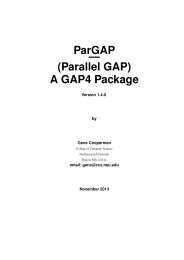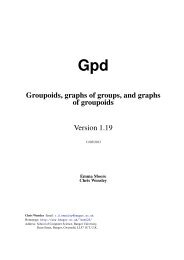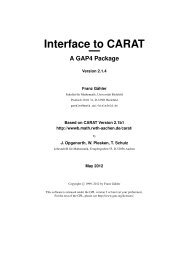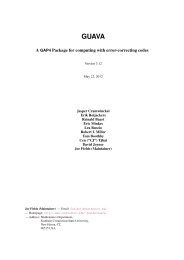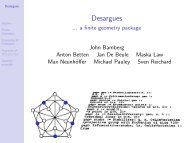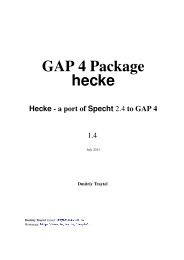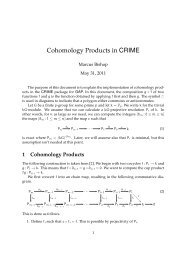Final Test in MAT 410: Introduction to Topology Answers to the ... - Gap
Final Test in MAT 410: Introduction to Topology Answers to the ... - Gap
Final Test in MAT 410: Introduction to Topology Answers to the ... - Gap
You also want an ePaper? Increase the reach of your titles
YUMPU automatically turns print PDFs into web optimized ePapers that Google loves.
1. compact,<br />
2. connected.<br />
(4 credits)<br />
Answer: A <strong>to</strong>pological space is said <strong>to</strong> be<br />
1. compact if every open cover possesses a f<strong>in</strong>ite subcover, and<br />
2. connected if it admits no nontrivial partition <strong>in</strong><strong>to</strong> open sets.<br />
Question 6: Give <strong>the</strong> def<strong>in</strong>ition of <strong>the</strong> diameter of a subset of a metric space. (2 credits)<br />
Answer:<br />
A × A}.<br />
The diameter of a subset A of a metric space (X, d) is sup{d(x, y) | (x, y) ∈<br />
Question 7: What is <strong>the</strong> difference between <strong>the</strong> Kle<strong>in</strong> bottle and <strong>the</strong> <strong>to</strong>rus? – Expla<strong>in</strong>.<br />
(3 credits)<br />
Answer: The <strong>to</strong>rus is an oriented surface, and it can be embedded without self-<strong>in</strong>tersection<br />
<strong>in</strong><strong>to</strong> R 3 . The Kle<strong>in</strong> bottle is a non-oriented surface which cannot be embedded without<br />
self-<strong>in</strong>tersection <strong>in</strong><strong>to</strong> R 3 .<br />
Question 8: Let R 2 be endowed with <strong>the</strong> usual <strong>to</strong>pology. Ei<strong>the</strong>r prove or disprove that<br />
[0, 1[×]0, 1[ and [0, 1[×[0, 1] are homeomorphic subspaces of R 2 . (8 credits)<br />
Answer: A nice proof (with illustrations, which I don’t want <strong>to</strong> copy here) that <strong>the</strong>y are<br />
homeomorphic can be found at<br />
http://www-his<strong>to</strong>ry.mcs.st-and.ac.uk/ john/MT4522/Solutions/S6.7.html<br />
For gett<strong>in</strong>g <strong>the</strong> credits, you were supposed <strong>to</strong> show that you have unders<strong>to</strong>od <strong>in</strong><br />
pr<strong>in</strong>ciple <strong>in</strong> what way a homeomorphism can map [0, 1[×]0, 1[ <strong>to</strong> [0, 1[×[0, 1].<br />
Explicitly determ<strong>in</strong><strong>in</strong>g an homeomorphism would be <strong>to</strong>o time-consum<strong>in</strong>g for an <strong>in</strong>class<br />
exam<strong>in</strong>ation, and was <strong>the</strong>refore not required for gett<strong>in</strong>g <strong>the</strong> full number of credits.<br />
One possibility <strong>to</strong> construct one is <strong>to</strong> partition source and range <strong>in</strong> a suitable way <strong>in</strong><strong>to</strong> 6<br />
triangles, each, and <strong>to</strong> use l<strong>in</strong>ear algebra <strong>to</strong> f<strong>in</strong>d 6 aff<strong>in</strong>e mapp<strong>in</strong>gs which map <strong>the</strong> triangles<br />
of <strong>the</strong> source <strong>to</strong> <strong>the</strong> correspond<strong>in</strong>g triangles of <strong>the</strong> range. This requires sett<strong>in</strong>g up and<br />
solv<strong>in</strong>g 6 systems of 6 l<strong>in</strong>ear equations, each. Of course <strong>the</strong>re are many o<strong>the</strong>r ways <strong>to</strong><br />
construct such homeomorphisms.<br />
Question 9: Let R 3 be endowed with <strong>the</strong> usual <strong>to</strong>pology, and let<br />
1. A := {(x, y, z) ∈ R 3 | xyz = 0},<br />
2. B := {(x, y, z) ∈ R 3 | xyz = 1},<br />
3. C := {(x, y, z) ∈ R 3 | x 2 + y 2 + z 2 = 0},<br />
4. D := {(x, y, z) ∈ R 3 | x 2 + y 2 + z 2 = 1} and<br />
5. E := {(x, y, z) ∈ R 3 | |x| + |y| + |z| ∈ Q}<br />
be endowed with <strong>the</strong> respective subspace <strong>to</strong>pologies. F<strong>in</strong>d out which of <strong>the</strong> <strong>to</strong>pological<br />
spaces A, B, C, D and E are homeomorphic (if any), and which are not. – Proofs required<br />
(no credits without arguments). (10 credits)<br />
Answer:<br />
2






